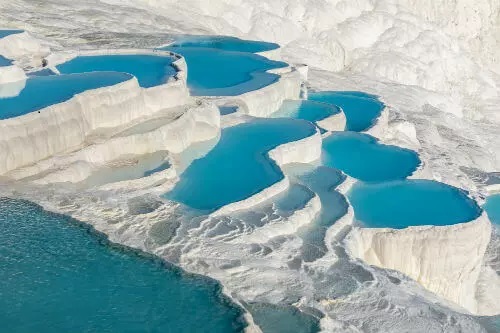The Pros and Cons of Travertine Countertops
When it comes to countertop options, the wide variety of available materials can be overwhelming. While quartz, granite, and marble all come to mind as common countertop surfaces, travertine is a lesser known alternative–however, its historical significance and natural beauty make it an increasingly popular choice for both kitchen and bathroom countertops.
What Is Travertine?
Travertine is a type of sedimentary limestone that forms from rapid precipitation of carbonate materials in wet environments such as hot springs and caves. Water rich with carbon dioxide flows through limestone rock, dissolving the limestone and releasing gases when faced with significant changes in pressure or temperature. The resulting calcium carbonate recrystallizes and hardens overtime, creating deposits of travertine.
The name “Travertine” is derived from Tivoli, a town in central Italy that contains extensive travertine deposits. Quarries in Tivoli and Guidonia, Italy have been mined for their travertine since ancient Roman times, and continue to be mined today. In the US, travertine can be found in abundance in Yellowstone National Park, due to high geothermal activity (i.e. hot springs) in the area.
In Colorado, travertine is probably best known for contributing to the formation of Hanging Lake, one of the state’s most popular natural tourist attractions. Hundreds of millions of years of dissolved limestone accumulations have resulted in layers of travertine along the shoreline, and are also responsible for the beautiful turquoise-colored waters as a result of dissolved carbonates.
Travertine Countertop Pros and Cons
Travertine is a popular countertop material, utilized for its luxurious, natural look that is often compared to more expensive materials such as marble. Homeowners value it for its sophisticated “chic” appearance and versatility, as travertine tiles can be used in showers, sinks, backsplashes, and other home areas both interior and exterior.
As with all countertop materials, travertine has both benefits and disadvantages. Aside from its natural and unique visual appeal, one of its most-often touted benefits is the price point; whereas other natural stone countertops such as granite, quartz and marble generally start at $15 per square foot, travertine starts at $11 per square foot.

Travertine is also valued for its highly reflective nature; a travertine countertop can add substantial brightness to a kitchen or bathroom from its reflection of light alone. Travertine is also prized for its durability against both stains and harsh weather conditions.
Versatility also plays a role. In tile form, travertine is easier to cut than other materials like porcelain, making it ideal for custom projects that may involve unusual shapes. Travertine countertops can be constructed using either slabs or tiles.
Despite its many advantages, travertine also has a few drawbacks. First and foremost, it is highly reactive with acids. Highly acidic liquids such as lemon juice, vinegar and wine will stain a travertine countertop more easily than other natural countertop materials such as granite. For this reason, countertop sealing is that much more crucial when installing travertine countertops, and must be revisited regularly to maintain their lifespan.
Another disadvantage of travertine is its soft, porous nature, which can increase the risk of scratching, etching, and other damage. Alkaline-based cleaners should be used to reduce the risk of abrasions.
Travertine is also more sensitive to heat than competing materials like granite. Cooling racks or hot hands are a requirement for preventing damage to your travertine countertops.
The disadvantages of travertine countertops are of most concern when they are installed in highly trafficked or highly utilized areas of the home. Kitchens that see heavy use, such as regular home cooking, are not the best candidates for travertine as high activity will deteriorate the countertop more quickly.
Conclusion
As a building material, travertine has an impressive legacy; ancient Romans mined it extensively for use in temples, monuments, aqueducts, and amphitheaters (the Colosseum is constructed mostly of travertine). It continues to be used to this day, being found in modern architectural feats such as the Willis Tower in Chicago.
As a countertop, travertine presents an attractive alternative to more expensive natural stones, with many homeowners choosing it for its close resemblance to marble. With an earthy, creamy color tone and a highly natural reflective surface, travertine works in just about any style home, from Spanish to Italian to French.
However, kitchens and bathrooms that are likely to see a high volume of traffic or use may be best suited for a more durable material. While travertine doesn’t lack durability, it’s porous nature and tendency to react with acids can make it less durable than competing countertop materials.
As always, it all boils down to personal preference. It may have a few drawbacks, but the increasing popularity of travertine speaks to its favorability as an excellent option for kitchen and bathroom countertops alike.
Rock Solid Custom Granite offers a variety of travertine countertop options. To learn more about our travertine countertops or to obtain a free estimate, contact us today!
